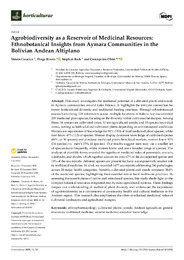Título :
Agrobiodiversity as a Reservoir of Medicinal Resources: Ethnobotanical Insights from Aymara Communities in the Bolivian Andean Altiplano |
Autor :
Cocarico, Simón
Rivera, Diego
Beck, Stephan
Obón, Concepción |
Editor :
MDPI |
Departamento:
Departamentos de la UMH::Biología Aplicada |
Fecha de publicación:
2025 |
URI :
https://hdl.handle.net/11000/38288 |
Resumen :
This study investigates the medicinal potential of cultivated plants and weeds
in Aymara communities around Lake Titicaca. It highlights the intricate connection between horticultural diversity and traditional healing practices. Through ethnobotanical
research involving 228 informants across multiple locations in Bolivia, we documented
239 medicinal plant species, focusing on the diversity within cultivated landscapes. Among
these, 56 species are cultivated crops, 17 are agricultural weeds, and 19 species have dual
status, serving as both wild and cultivated plants depending on environmental conditions.
Women are repositories of knowledge for 81% (193) of total medicinal plant species, while
men know 47% (113) of species. Women display dominant knowledge of cultivated species
(89%, or 50 species) and purchase medicinal plants from local markets; women know 92%
(24 species) vs. men’s 15% (4 species). Our results suggest men may use a smaller set
of species more frequently, while women know and use a broader range of species. The
analysis of plant life forms revealed the significant medicinal roles of perennials, annuals,
subshrubs, and shrubs, which together account for over 67% of the documented species and
73% of the use reports. Arboreal species are present but have a comparatively smaller role
in traditional medicine. In total, we recorded 1477 use reports addressing 260 pathologies
across 28 major health categories. Notably, cultivated plants and weeds represent 38.8%
of the medicinal species, highlighting their essential role in local healthcare practices. By
assessing the contributions of native and introduced species, this study sheds light on the
complex botanical resources integrated into Aymara agricultural systems. These findings
deepen our understanding of medicinal plant diversity and underscore the importance
of agrobiodiversity as a cornerstone of community health and cultural resilience in the
Andean region. This research also emphasizes the often-overlooked medicinal value of
cultivated landscapes and agricultural margins.
|
Palabras clave/Materias:
ethnopharmacology
cultivated plants
Andean agriculture
weeds
genetic resources |
Área de conocimiento :
CDU: Ciencias puras y naturales: Biología |
Tipo de documento :
info:eu-repo/semantics/article |
Derechos de acceso:
info:eu-repo/semantics/openAccess |
DOI :
https://doi.org/10.3390/horticulturae11010050 |
Publicado en:
Horticulturae 2025, 11(1), 50 |
Aparece en las colecciones:
Artículos - Biología Aplicada
|
 La licencia se describe como: Atribución-NonComercial-NoDerivada 4.0 Internacional.
La licencia se describe como: Atribución-NonComercial-NoDerivada 4.0 Internacional.
.png)
